Demand for telecrawlers continues to grow
07 September 2021
The once niche market telescopic crawler is now a rental fleet mainstay.
Twenty-five years ago, just one company made telescopic crawler cranes for the U.S. market. At that time, the market for these machines was small – mainly powerline companies.
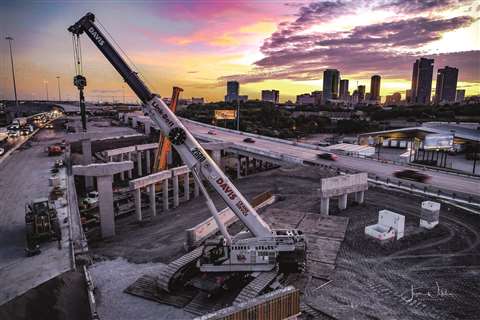 Davis Crane’s Link-Belt TCC-2500 works on a highway project in North Dallas.
Davis Crane’s Link-Belt TCC-2500 works on a highway project in North Dallas.
But a handful of crane OEMs saw the potential for this hybrid machine that married the rugged mobility of a crawler crane with the easy operating telescopic boom on rough terrain, all-terrain and truck cranes. Today, four companies produce conventional telecrawlers for the U.S. market, and the markets they serve are growing exponentially.
The Liebherr LTR 1040 is the latest member of the Liebherr telescopic crawler crane family. The 50-tonner offers excellent value it this class, Liebherr said. At 131 feet, the telescopic boom is some 30 percent longer than other cranes in this class. This is a plus in the assembly of precast concrete parts and in steel construction. Most crane jobs can be performed without a folding jib.
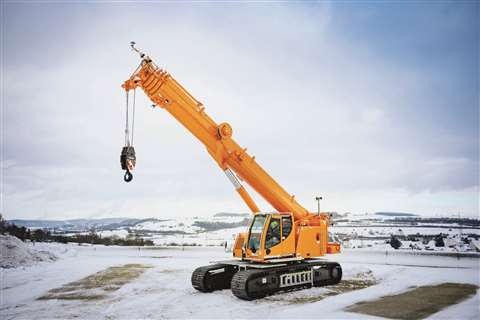 The Liebherr LTR 1040 is a weight-reduced version of the LTR 1060.
The Liebherr LTR 1040 is a weight-reduced version of the LTR 1060.
The LTR 1040 is a weight-reduced version of the LTR 1060. The main difference to the LTR 1060 is the significantly reduced ballast: the LTR 1040 is 20 metric tons (44,100 pounds) lighter overall. Part of the central ballast is eliminated on the chassis, and additional tons of counterweight are saved on the slewing platform. Owners have the option of upgrading to the LTR 1040 to the LTR 1060 at a later date, if required.
The LTR 1040 weighs 95,900 pounds, including its 12,300 pounds of ballast. By removing 11,000 pounds of ballast, the weight of the LTR 1040 can be reduced to 84,900 pounds. With an 8.2-foot erection jib and a second hoist unit, it can also carry out work in 2-hook mode.
Rick Mikut, manager of the crawler crane division for ALL Erection & Crane Rental, said telescopic crawlers cover most every market his company serves.
“Everything from bridge work and new construction to plant work and, as always, wind energy,” he said. “Their mobility is also particularly useful as assist cranes during assembly and disassembly of other larger units.”
Value for the dollar is the reason telecrawlers perform so well, Mikut said.
“The best value in its class, the telescopic crawler is well-suited for general construction or any place where tires might be a hindrance, including foundations, bridges, rail construction and power transmission,” he said. “They’re highly versatile, which is why they’re so popular. You find them in just about any application where you need the ability to move in close or walk with a load.”
Telecrawlers can’t be beat for certain kinds of plant work during scheduled outages for maintenance, Mikut said.
“With a rough terrain crane, we might have to tear down every time we have to relocate,” he said. “Even if that only takes 30 minutes each time, if you do it four times in a day, that’s two hours the customer has lost just in set-up time. A telecrawler can crawl right in where it needs to go. Think about it, for petrochemical, chemical and power plants, these machines can even bolt down and crawl under a pipe rack, which saves a lot of time.”
Strong product offerings
While the telecrawlers in ALL’s feet are mainly Link-Belts, Mikut said all the OEMs are producing strong products.
“Their ability to move on softer ground is a huge advantage,” said Mikut. “Telecrawlers become indispensable on work sites where a rough terrain or all-terrain crane can’t go, or on a site that a conventional crawler crane utilizing flat pads can’t navigate.”
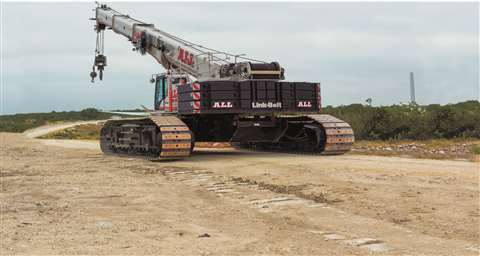 Telescopic crawlers are a mainstay in the ALL Erection & Crane Rental fleet.
Telescopic crawlers are a mainstay in the ALL Erection & Crane Rental fleet.
Another invaluable feature of telecrawlers is their agility. Working off-center comes easily to a telecrawler, Mikut said.
“This is huge on unmanicured worksites,” he explained. “Traditional truck cranes and RTs require absolute centering for balance. The newest telecrawlers have computer systems and charts for working out of level from minus one to minus five degrees. With an RT you have to pick up the outriggers and cribbing and move, fold in the boom, where the telecrawler can move according to ground conditions with boom out.”
Unlike a traditional crawler, the telecrawler’s boom is not fixed, so obstructions encountered on jobsites do not require moving the crane and rebuilding the boom, Mikut said.
Telecrawler design continues to evolve, making these units versatile and agile.
“The footprints of telecrawlers have gotten narrower, booms are lighter and transportability has improved,” said Mikut. “Capacities in the range of 50 to 75 tons are popular for plant work, bridge construction and tank work. The 110-ton models are big in new construction and wind. Our 140-tonners do wind as well as crane assembly and plant work. New, higher-capacity telecrawlers excel in environments common to road and bridge construction and wind.”
Telecrawlers are infringing on other classes of cranes.
“They have taken a lot of work from RTs because of telecrawlers’ ability to better handle softer and unlevel ground conditions,” said Mikut. “But that just frees up our RTs to respond to other, more appropriate jobs. Customers highly prize the mobility of telecrawlers.” Mikut considers the telecrawler to be an “awesome addition” to ALL’s fleet.
“They’re always in demand,” he said. “We started buying big in 2010 with the introduction of Link-Belt’s TCC-750, knowing the technology had really found its moment. Today, we have nearly 50 telecrawlers in our fleet.”
With the launch of the Grove GHC110, Manitowoc added an important machine to its growing telescoping crawler crane range. With a capacity of 110 tons, the GHC110 joins the recently launched GHC140 telecrawler in the lineup.
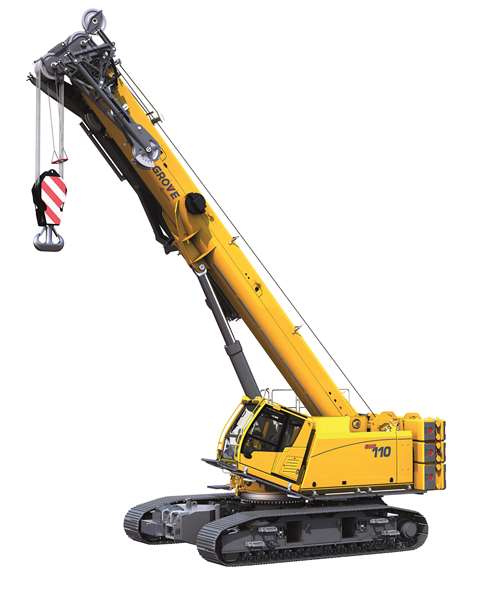 The Grove GHC110 will be shown for the first time in North America this month at The Utility Expo on Louisville, KY.
The Grove GHC110 will be shown for the first time in North America this month at The Utility Expo on Louisville, KY.
This crane is designed for a range of tasks, including alternative energy applications, road and bridge construction and utility and barge work. The GHC110’s versatility is enhanced with the optional personnel basket attachment with radio remote control.
Now available in the Americas, the Grove GHC110 will make its debut at The Utility Expo this month in Lousiville, KY. (See our Utility Expo Show Guide on page 52.)
The GHC110’s five-section main boom extends from 40.4 to 153.4 feet, producing a maximum tip height of 162 feet, or 212 feet when a standard 49.2-foot bifold offsettable swingaway boom extension is added. The main boom sections are quickly and efficiently moved into the required positions using two horizontally mounted pins and a single telescopic cylinder, Manitowoc said.
The GHC110 offers 100 percent pick-and-carry capability across its standard 0.6, 1.5 and 4 degree load charts. Although the actual allowable grade for travel with no load is 36 percent, the unit’s gradeability makes travel possible at a theoretical 57 percent.
The GHC110 is powered by a Cummins QSB6.7 Tier 4 Final engine rated at 249 hp/186 kW. A single variable displacement load sensing piston pump distributes power for all main functions, with a maximum operating pressure of 330 bar (4,786 psi).
Pick and carry
Buckner HeavyLift’s (BHL) Jay Breitbach said that his company’s telecrawler fleet is mostly utilized by customers with large wind turbine erection projects.
“On wind farm projects, the Liebherr LTR1100 pairs well with 440 to 660-ton cranes, and the Liebherr LTR1220 pairs well with 825 to 1,500-ton cranes,” said Breitbach. “The versatility of these cranes allows them to be helpful with the assembly, disassembly and moves of larger cranes, offloading and tailing.”
Buckner’s customers choose telecrawlers for their ability to pick and carry and their robust crawler system, which allows them to work in difficult terrain, he said.
“Telecrawlers can also retract their side frames and boom, so they can walk with a smaller footprint like the footprint of a standard RT crane,” Breitbach said.
Buckner’s telecrawler fleet will continue to grow, according to Meredith Williams.
Link-Belt TCC-550
Link-Belt Cranes’ latest telescopic crawler is the new 55-ton TCC-550. Production has begun and shipments are set to begin in the fourth quarter of 2021.
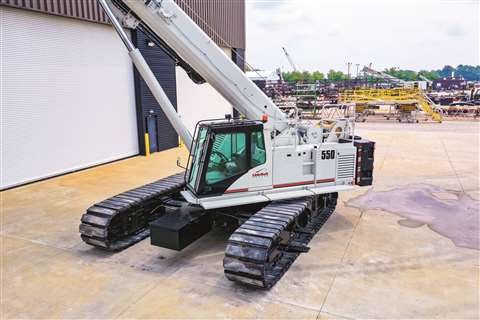 Link-Belt’s TCC-550 was designed to transport in just one load with a standard counterweight package of 25,000 pounds.
Link-Belt’s TCC-550 was designed to transport in just one load with a standard counterweight package of 25,000 pounds.
The TCC-550 features a full-power 36.5 to 115-foot four-section boom with two boom extend modes (EM1 and EM2) and a strong chart, Link-Belt said. The entire boom is greaseless and includes Link-Belt’s Teflon-impregnated wear pads for easy maintenance. Fly options include a 28.5 to 51-foot two-piece bi-fold lattice fly, stowable, offsetable to 2, 20 and 40 degrees; maximum tip height is 165.5 feet.
Durable textured and slip-resistant paint on all walking surfaces is new and improves footing. The vision package includes winch-view camera, rear-view camera and right-side swing camera, giving the operator great jobsite visibility during setup and lifting. Anchor points are located on the work platform of the TCC-550 for personal fall arrest equipment.
The TCC-550 can work at three different track widths: 15 feet 2.37 inches fully extended; 13 feet 6.11 inches intermediate; and 11 feet 5.24 inches retracted. It has two travel speeds and can travel up to 2 miles per hour (3.2 kph) to spend less time traveling and more time lifting.
Link-Belt designed this crane to move quickly and easily on or off the jobsite. With a standard counterweight package of 25,000 pounds, the TCC-550 transports in just one load while staying under 100,000 pounds. On the trailer, the TCC-550 travels at a height of 9 feet 10.55 inches and a width of 11 feet 5.24 inches.
“Within the past decade, telecrawlers have become increasingly popular on a multitude of jobsites due to their strength and flexibility on difficult and narrow terrains,” she said. “We continue to see this demand grow in multiple markets that we serve, from wind to more traditional power, infrastructure and stadium work.”
She said Buckner HeavyLift has the largest fleet of Liebherr telecrawlers in the U.S., with more than 40 LTRs.
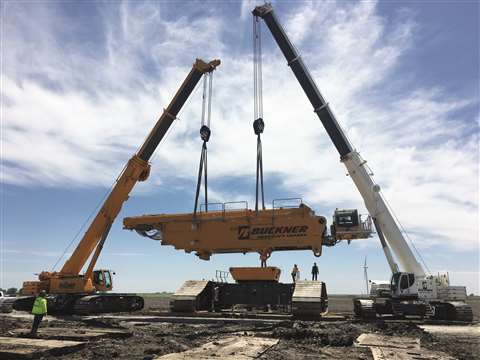 Two Buckner HeavyLift telecrawlers assemble a larger crawler crane at a wind farm.
Two Buckner HeavyLift telecrawlers assemble a larger crawler crane at a wind farm.
“BHL is expanding our world class telescopic crawler fleet to include the limited edition Liebherr LTR 11200 in 2021,” she said. “This model offers a luffing jib option as well as a maximum tip height over 600 feet.”
The smaller footprint with narrower tracks, lighter boom and easy transportation are why the market for these cranes is growing.
“Telecrawlers are able to be utilized in rough terrain where other models are not as nimble,” said Williams. “Telescopic crawler cranes offer a variety of solutions to site conditions that rubber-tired mobile cranes cannot achieve, such as pick and carry, retractable footprint during site walking and the telescopic crawler’s ability to remain mobile in soft soil conditions and challenging grades above 15 percent. These cranes also offer an additional safety aspect from many of these features which makes them an ideal crane for many projects.”
Buckner’s Dan Ives said an often overlooked aspect of telecrawlers is that they have much more usable load chart than an outrigger-supported crane.
“A typical rough terrain crane, for example, will have a strong load chart below a radius of 20 feet, but it can be very difficult to make those lifts because of clearance required for the crane’s outriggers,” Ives said. “A telecrawler doesn’t have the same issue, because its tracks take up a smaller footprint than the outriggers would. This allows a telecrawler to match performance of a rough terrain crane with a larger tonnage.
To illustrate that point, the Liebherr LTR 1100 is a 110-ton crane, but it can match the performance of a 130-ton rough terrain crane, and a 110-ton rough terrain will not be able to match the lifting capability of the LTR 1100. You can assemble an LR 1600/2 with an LTR 1100, but you cannot get that job done with a 110-ton rough terrain or all-terrain.
Evolving market
Jon Johnson, general manager of Davis Crane Service, said the market for telecrawlers in the North Texas region is evolving.
“Our customers have been able to personally experience the versatility of these cranes therefore giving telecrawlers an established reputation and a surging market demand.”
Davis Crane’s telecrawlers are used by a diverse array of customers, including foundation drilling companies and general contractors. Davis Crane relies on the Link-Belt brand of telecrawlers.
“Our 110-ton has the highest demand,” Davis said. “With its capacity, ease of delivery and set up, we have encountered a rising demand for this particular size. The market will continue to expand as this crane consistently demonstrates its effectiveness and proficiency.”
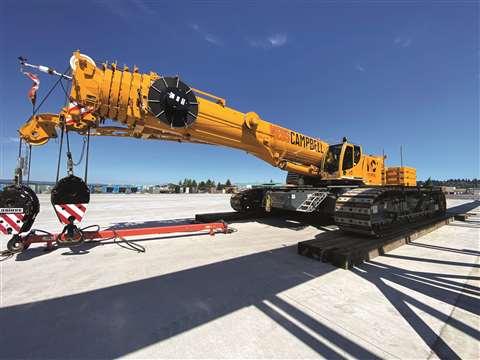 Demand for telecrawlers in the Pacific Northwest is picking up. The Liebherr LTR 1220 is a popular crane in the fleet of NessCampbell.
Demand for telecrawlers in the Pacific Northwest is picking up. The Liebherr LTR 1220 is a popular crane in the fleet of NessCampbell.
In the Pacific Northwest, Ness Campbell’s John Anderson said the market for telecrawlers is growing as contractors are introduced to this concept of crane and realize its versatility.
“For now, it looks to me that many of the foundation contractors are utilizing these machines,” he said. “I have also seen the steel erectors starting to use this type of crane. And of course, they are highly utilized in the wind market.”
NessCampbell owns one telecrawler, the 275-ton capacity Liebherr LTR1220.
“For me it’s the ability to pick and walk with the load; it allows us to use a smaller crane and move around the jobsite in a timely manner,” he said. “I have seen the telescopic crawlers mainly replace RT cranes in the same class. I believe this market sector will continue to grow, as the manufacturers continue to add larger capacities and different boom and jib options, they will continue to become a great option for our customers.”
Filling a gap in the telescopic boom crawler market, the Tadano GTC-1600 brings a 160-ton capacity solution to the lifting industry with over 200 feet of main boom length and out-of-level operation on slopes up to 4 degrees. The GTC-1600 is equipped with the Opti-Width flexible track position system that facilitates limitless combinations, symmetrical and asymmetrical track width setups with no requirement for pinning of the track frames in fixed positions.
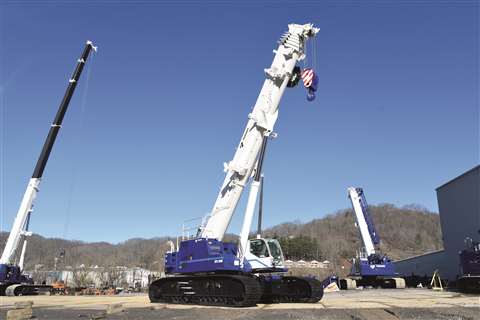 The Tadano GTC-1600 features the company’s Opti-Width flexible track position system.
The Tadano GTC-1600 features the company’s Opti-Width flexible track position system.
The GTC-1600’s hydraulic system makes for smooth and seamless multi-function operation, allowing travel, hoisting and boom telescoping all at the same time. These longer, smarter and stronger capabilities make the GTC-1600 well-suited for a variety of construction and specialty lift work applications, while expanding the GTC product line to seven models.
The Tadano GTC-1600 has a 6-section boom with that can extend from 42.8 feet to up to 200.1 feet, making it the longest boom in the under 250-ton class of teleboom crawlers. The boom uses a reliable single-cylinder telescoping and pinning system to extend and retract all of the sections automatically and can be locked in selected working positions.
Complimenting the boom is a 33.8 to 59.1 foot bi-fold jib with offsets of up to 40 degrees. A jib length of up to 105 feet is possible with two 23-foot optional lattice insert, facilitating a maximum tip height of 305 feet. An optional 11.8 foot heavy-lift jib with 20 and 40 degree offsets is also available and is ideal for tilt-up work in tight spaces.
STAY CONNECTED


Receive the information you need when you need it through our world-leading magazines, newsletters and daily briefings.



